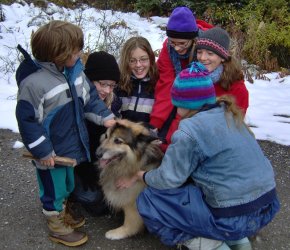Composting Pet Waste - The Ultimate Pet Waste Disposal System
Composting Pet Waste
We've all been told that dog and cat waste has no place in the compost pile. However, there's something inherently wrong with carefully filling plastic bags, which take roughly a thousand years to decompose, with biodegradable poop that is three quarters of the way to compost already.
Landfills are Bad Places for Poop
Nine times out of 10 these bags are bound for the landfill. Not only are landfills filling up too fast, they are not designed to handle biodegradable wastes well. They are a problem being put off for future generations if gas and leachate systems should ever fail.
The real question is not whether a composting pet waste disposal system will make compost, it is whether or not the compost is safe to use in a garden growing food.
On one of the forums I follow a fellow gardener says it perfectly:

Not using YOUR dog or cat manure isn't to protect you or your family. It's to contain, except for your family, any disease YOUR dog or cat might have. It's to protect ME from any disease YOUR pet might have already given YOU. A good rule if you sell what you grow.
The Alaska Study
The average dog excretes about three quarters of a pound of waste a day. Do the math and you have about 274 pounds a year. Not too big a problem. But when you add all the dogs in town to the mix it adds up.
In Alaska this is literally a mountainous problem. It's estimated that the pooches of Fairbanks and Anchorage alone generate roughly 20 million pounds of dog waste a year.
Mushers, those intrepid northern souls who travel by dogsled, naturally have many dogs. A modest sized musher's kennel would be home to 20 dogs. With 20 dogs to pick up after, at 274 pounds of poop per pup, you end with an annual dung heap weighing 5,480 pounds - close to three tons.

Hauling all this to the landfill is a poor solution. So USDA, NRCS and the Fairbanks Soil and Water Conservation District teamed up with the mushers to fearlessly explore composting dog waste.
The Scoop on Composting Poop
The Alaska Study found composting to be a workable way to handle dog waste. They tested big piles in pallet made bin systems, smaller piles in wire enclosures and even composted pet waste in the typical municipal home owners backyard plastic bin. All yielded a good finished compost. However the smaller scale composts may have a few more pathogens in them due to lower composting temperatures.
Composting dog waste:
- Removes raw waste therefore avoiding surface and ground water pollution.
- Destroys pathogens and produces a good safe soil amendment.
- Done on-site reduces hauling and saves money, energy and landfill space.
The Alaska study did not include cat poop so does not recommend composting cat feces. However, I am prepared to say why not. The only serious consideration is the type of kitty litter you use. Look for a biodegradable brand and toss the scooped poops in with your separate pet waste compost.
The Alaska study found that maintaining a large hot compost system required a minimum of 10, preferably 20 dogs.
Most of us do not have that kind of dog livestock. For us it is more appropriate to go with a smaller composting pet waste disposal system. Even using one of the small plastic compost bins you can often get through your town is an acceptable way to composting pet waste.
Guidelines for Composting Pet Waste
You want to channel all the pet waste into one bin - one whose finished compost will not be used on your edible crops.
The guidelines for a composting pet waste disposal system are:
- Use your finished compost on your ornamental and landscape garden areas. Do not use this compost on root, stem and leaf vegetables. You could safely use it however on berry bearing shrubs and fruit and nut trees.
- The C/N ratio of dog and cat poop will be similar to human feces - which depending on diet is about 6 to 10. This means 6 - 10 parts carbon to 1 part nitrogen.
- Ideal composting is a C/N ratio of about 25 - 30. You'll get this with about two scoops or shovels full of pet waste to one of a high carbon material like straw or sawdust.
- Compost from a pet waste disposal system can be high in salts. These will balance if you allow the compost to cure for several months before using. Curing involves just letting a pile sit for a while.
- If your dog or cat is sick as a precaution don't add that poop to the pile during their illness. You could flush it for the duration.
Biodegradable Bags vs Compostable Bags
The issue dog owners face is poop collection. We've often solved it by collecting droppings with any one of the plastic bags that come to us in normal everyday use. While this is a form of reuse those bags make composting pet waste challenging.
I spoke with Rose at EnviroWagg in Colorado. She runs a dog waste composting program that involves collecting and then composting canine doo from several parks and dog day care facilities in her area.
A huge part of composting pet waste is dealing with the plastic bags. They have to send the bagged poop through a grinder to open the bags and begin the compost process.
Even though the places where they collect the waste provide biodegradable dog waste bags the grinding is essential. At the end of the process they still have to screen their product to eliminate the bits of "biodegradable Plastic".
What is the Difference between Biodegradable and Compostable?
Regular Plastic bags take about 100 years to break down and will protect your dog poop in a mummified parcel in a landfill for the duration.
Biodegradable Bags
Most if not all Biodegradable Bags still have the large molecules of plastic in them but they also have an additive that allows them to fragment. Essentially the bags breaks into tiny pieces but it will still take a good long while for the actual molecules of plastic to decompose into CO2 and H2O.
These bags take around 12 to 18 months to fragment. This will seriously slow down your pet waste disposal system.
Compostable Bags
Compostable Bags are usually corn based and break down the same as compost - in 40 days or so. In theory you would not have to open them - but my guess is that doing so will speed things up considerably.
For larger scale pet waste disposal systems dealing with bags from a whole park a compostable bag would be a huge advantage as the resulting compost would have no plastic contaminants. Currently the down side of this is cost. Compostable bags cost about double what the regular biodegradable bags cost.


